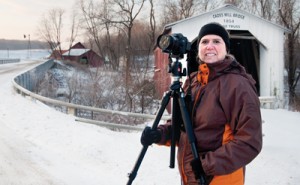 The winter sunrise had just begun turning the tree tops along the ridge to the west into a vein of gold against the pale blue sky. But shadows still veiled the snow-covered land down in the hollow where the road crossed over Coal Creek.
The winter sunrise had just begun turning the tree tops along the ridge to the west into a vein of gold against the pale blue sky. But shadows still veiled the snow-covered land down in the hollow where the road crossed over Coal Creek.
There, Marsha Williamson Mohr pulled her white Subaru off to the side. The outside temperature gauge on her dashboard said it was in the single digits. It felt maybe even colder as she emerged with a tripod and camera on this January morning. She noted the thick hoarfrost twinkling tremulously in the air and flocking every twig and stem of grass as she walked down the road past the Cades Mill Covered Bridge toward a red barn.
A day off from her profession — as a registered nurse — gave Mohr the chance to pursue her passion: photographing barns and bridges and scenery of rural Indiana. Despite the cold, the day’s sunny forecast following freshly fallen snow drew her from her Tippecanoe County home early. Though she traveled this road to Fountain County before to capture images of these same structures at other times of the year, the fleeting variation of the snowy landscape and frosty air glistening in the morning light was an irresistible invitation to add to her large stable of photos.
“It’s like a collection of golf balls,” she said. “I have fog morning shots and I have sunrise and things. But I don’t know if I have ‘snow-sunrise-fog’ shots. So, I’m always looking out for something I don’t have.”
Mohr, 58, began shooting photos back when she was in 4-H in the 1960s. She made it a part-time job just over 20 years ago when she began working to get her photos published. She has since been published in magazines and calendars.
At the end of November, Quarry Books, an imprint of Indiana University Press, published Mohr’s second book of photos, a collection of 155 barn photos culled from her portfolio.
Mohr’s first book of photos, The Quiet Path: Covered Bridges of Indiana, was published nine years ago, sponsored by Electric Consumer. That book, written by her father, Maurice Williamson, was featured in Electric Consumer, too.
In the years in between, she did put together a series of other titles under the “The Quiet Path” which are available through “print on demand” on her website. Those books include Lake Tahoe, Round Barns of Indiana, the seasons and Purdue University. She’s currently out to capture waterfalls, and she’s been asked to put together a book of photos from Warren County.
But covered bridges and barns have been the bread and butter for the Tipmont REMC consumer. That focus, she said, helped her get published initially. “There are a million photographers out taking landscape pictures, waterfalls and national parks and things, and a lot less taking photos of barns. It limited the amount of competition I had.”
Covered bridges, she said, are magical. “I don’t know what excites me about the barns. … Barns say a lot to me as far as the texture of them. Weathering fascinates me. If they’re weathered, I love to just zoom in on just a particular part of the barn.”
Most of Mohr’s work is done from the road side. When she occasionally has to stop and ask permission to get on the barnowner’s property to get the shot she wants, they’ll sometimes say, “Why do you want to take that ugly old rickety barn for?”
She said she tells them, “Oh no, it’s beautiful.”
“I love the newer ones and the freshly painted ones,” she added, “but it’s the older ones that are probably my favorite.”
Because photography isn’t her main livelihood, she admits she doesn’t have the luxury of time to always pursue the primo lighting conditions as she wish she could. She’s literally barnstorming on many of her outings.
“I compromise by getting as much as I can while I’m out there,” she said. “I’m working pretty hard and fast.”
That’s especially true when she’s traveling out of state. “You never know what’s ahead of you that might be that one picture to die for.”
She feels a touch of urgency, too, in her work not just because of her time constraints, but because of what passing time does to her subjects. Too often that quaint, weathered barn she passed one week with the notion of shooting at a different time under different conditions, was no longer there when she came back.
Still, the theme running through her work and her life is to “slow down” and take “the quiet path.” The covered bridges and old barns she loves so much echo to slower times when people seemed to take greater pleasure in their natural surroundings and the simple things in life. “Sometimes, I don’t have an agenda,” she said about heading out to photograph. “I just take a left and a right, and if one road looks a little more attractive to me, I’ll take it. I love that.”
That love for adventure she traces back to 1964. When she was 11, she and her family — dad, mom and 13-year-old brother — sat shoulder to shoulder across the bench seat of an International pickup truck on an 8,000-mile, month-long vacation from West Lafayette to the Pacific Ocean and back. A lover of geography, she navigated as they ventured to all the notable national parks.
With her Indiana Barns book, she was recently reminded how special it is for her to capture this passing rural heritage. “I had a doctor tell me when the book came out that he thought it was really cool that I was doing a job that would last forever — for generations and generations to come,” she said. Some of the barns she preserved in print in the book, for example, have already disappeared from the country side.
“It’s a passion. I am always trying to get that special shot,” Mohr said. “I appreciate both jobs — I can be a nurse and care for people. But I just love being out by myself just taking pictures, getting that composition. I just really value the fact that I was taught to appreciate nature and life, and to live it to its fullest.”



